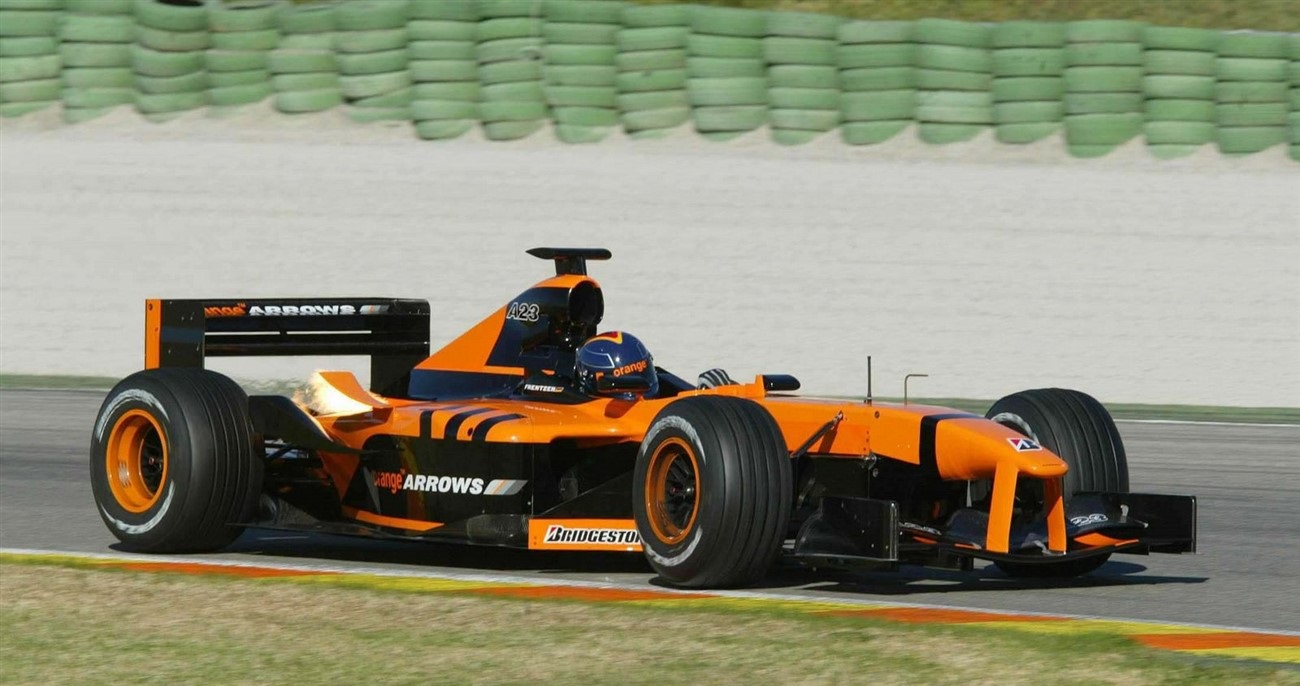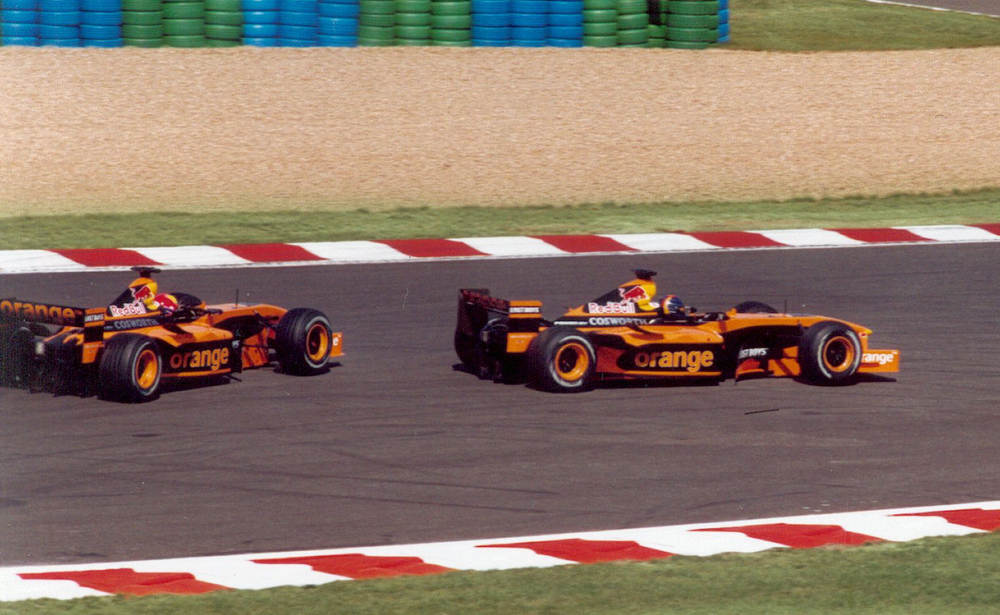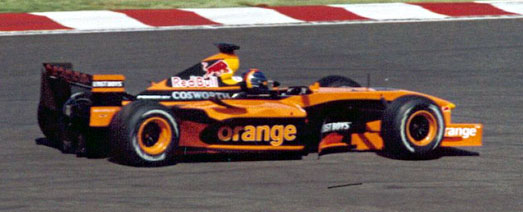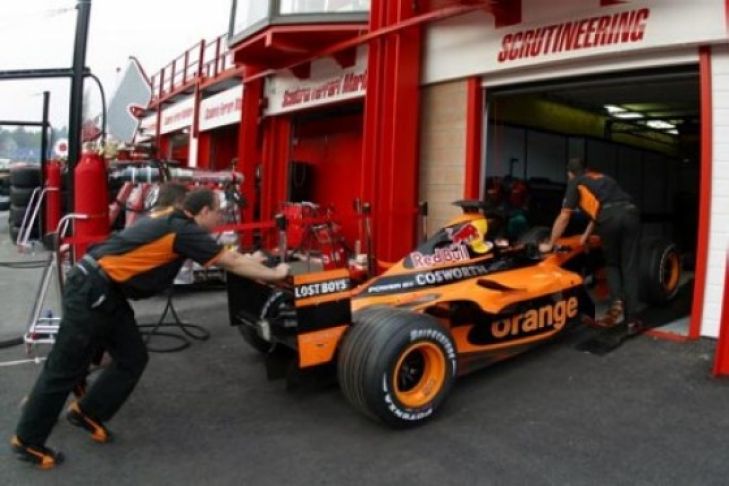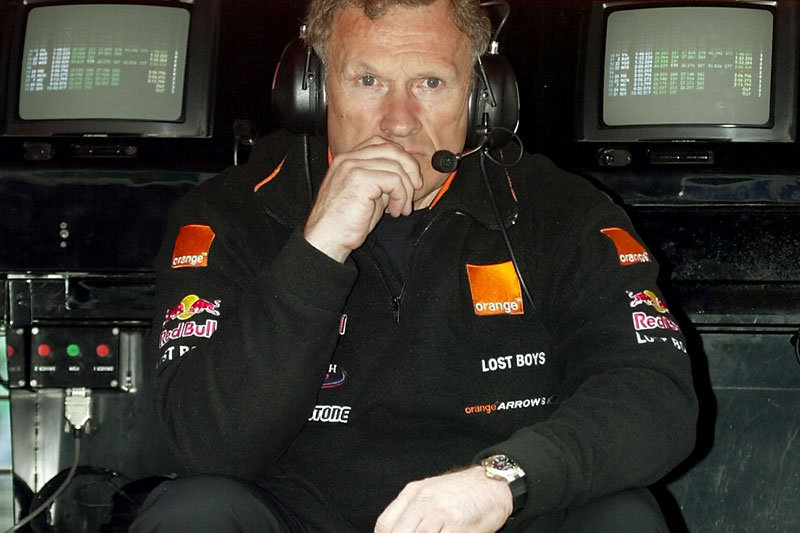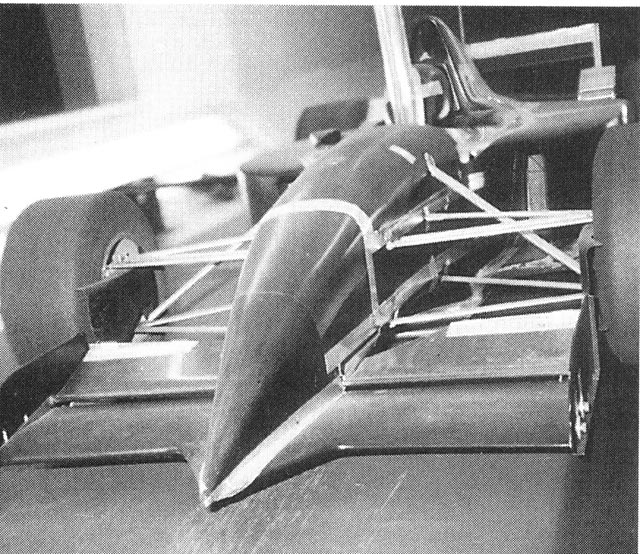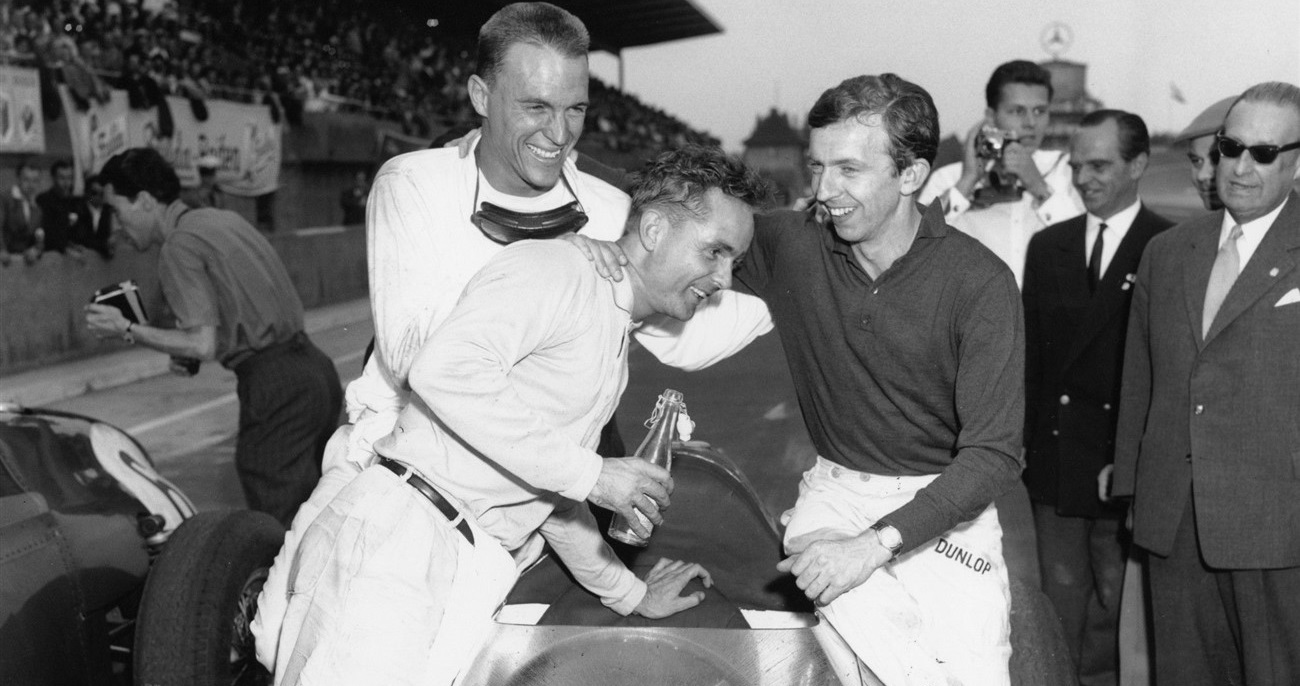March 2002 the Formula One arrives at Albert Park in Australia for the first race of the season. Prost Grand Prix is missing and three other teams are struggling to stay on the grid Minardi, Jordan Grand Prix and Orange Arrows. Six months later Arrows disappeared from the grid due to mismanagement and a lack of financial backing. A messy season with one highlight the Arrows A23, a car I would call pure F1 porn, I know it is unappropriated to say these days. The A23 showed it’s progression and would twice re-appear on the track. Enjoy Part One of the Arrows A23 special.
A lot has been written after Arrows disappeared from the grid. Many blame Tom Walkinshaw for the downfall of the Arrows team. However, I still believe that Walkinshaw had the best in mind for the team. He is still one of the few, I believe, with a huge passion for motor sports. Who doesn’t remembers the Jaguars in Le Mans?
Still, the fact is that Arrows is financially struggling in 2002. Jos “The Boss” Verstappen signed in 2000 a three-year deal to drive for the Orange Arrows team. A decent driver and probably the only one that could bring the team to a higher level. The Arrows A23 was built around Jos Verstappen; it means most of the input came from Verstappen himself. However, before the testing begins in February 2002 Verstappen got ditched in favour of Heinz-Harald Frentzen. Enrique Bernoldi stayed as second driver.
Perhaps there was another factor for the downfall of the team. When Prost Grand Prix went bankrupt, there were several groups interested in the assets of Prost Grand Prix. One of them was Tom Walkinshaw together with Charles Nickerson who purchased most of the assets. Phoenix Grand Prix was born and prepared themselves to arrive on the grid in Australia. Walkinshaw was not fully concentrated on the Arrows Team at this point. However, money equals money in the Formula One. In the end, Phoenix Grand Prix never appeared on the grid as you can read here.
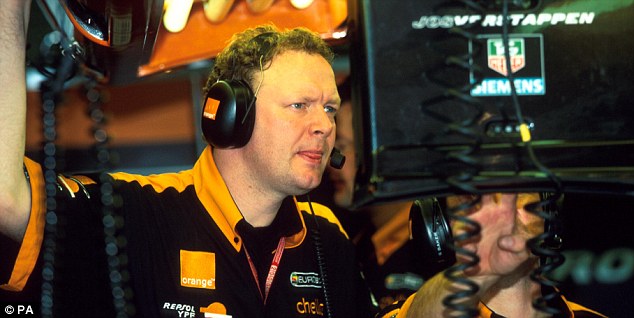
Mike Coughlan at Orange Arrows 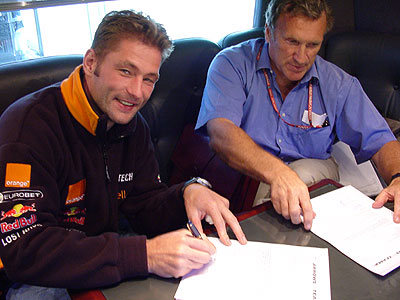
Verstappen signing his contract for 2002 at Orange Arrows
Whatever exactly happened after Prost Grand Prix went into bankruptcy and the plans Walkinshaw had, we will never know for sure. What we do know is the fact that Arrows produced the successor of the A22 the A23. Mike Coughlan (later known for the spy gate) designed the car. Personally, it’s one of my favourite cars and equals the beauty in lines of the Jordan 191, the Modena or the Ferrari Shark nose. The Arrows A23 had one of the beautiful test liveries ever seen in the Formula One, the livery showed the sweet lines of the car. The extreme Twin Keel completed the looks.
Was Arrows moving in the right direction with the Arrows A23? I believe so, the team finally realised they needed a strong engine, as previous year the Asiatech was a questionable one. The engines were ex-Peugeots from the year before. For 2002, the team signed a deal with Cosworth to supply them with the needed power. Mike Coughlan and his team of twenty engineers worked full-time on the car during the winter of 2001-2002. The airbox was rounded, the front wing was higher and the side pods became longer. Most revolutionary on the car was the developed Twin-Keel from Sergio Rinland who arrived in late 2001 at the team.
Sergio Rinland was one of the first to introduce the twin-keel concept on a F1 car. In 2001, Rinland designed the Sauber C20, which had the twin-keel. The idea behind this concept is an improved airflow underneath the nose of the car. It exists out of two plates protruding from the bottom of the nose sides. There are a couple of cons for the idea. A twin keel adds to the engineering complexity of the suspension, it makes it heavier and it makes it harder to make addition to the additions when the twin keel in mounted. However, the aerodynamic benefits outweigh these concerns. Many teams adapted the twin keel eventually.
As mentioned already Arrows was to race in 2002 with the Cosworth CR V10 natural aspirated engine. The package look good, if you look at Cosworth’s history in the sport you will understand why. Besides Arrows Jaguar Racing was using the engines in 2002 as well. Sadly, the Cosworth engine in 2002 was not that reliable for both teams. When Cosworth came with the C4, it was still far from reliable. Was the engine one of the nails in the coffin? Probably yes. The results for both teams were far from best most of the times.
While the team’s plan was to test an interim car in January testing, as announced by the team on the 7th of January 2002, the design team did not agree with the plan of sending an interim car to the track for test work. They wanted to keep all the focus on the design of the Arrows A23. On the 3th of February the experienced, it’s first shakedown with Enrique Bernoldi. I was unable to find out on what track this happened. A day later, a second shakedown was held on the old airfield of Kemble (Goucestershire).
Valencia Testing 6 – 8 February 2002
On the 6th of February 2002 the Arrows A23 completed it’s first testing at Valencia. Enrique Bernoldi realised a best time of 1:16.586, while Heinz-Harald Frentzen showed the real potential of the car a day later. With a 1:15.131 he was more than 1,4 second faster than Bernoldi. On the 8th of February Frentzen went even faster with a 1:13.496 as is best time. You can read the test reports per day by the links below;
test Report 6 Feb , Test report 7 Feb,
Valencia Testing 6 – 8 February 2002
On the 6th of February 2002 the Arrows A23 completed it’s first testing at Valencia. Enrique Bernoldi realised a best time of 1:16.586, while Heinz-Harald Frentzen showed the real potential of the car a day later. With a 1:15.131 he was more than 1,4 second faster than Bernoldi. On the 8th of February Frentzen went even faster with a 1:13.496 as is best time. You can read the test reports per day by the links below;
test Report 6 Feb , Test report 7 Feb, Test report 8 feb
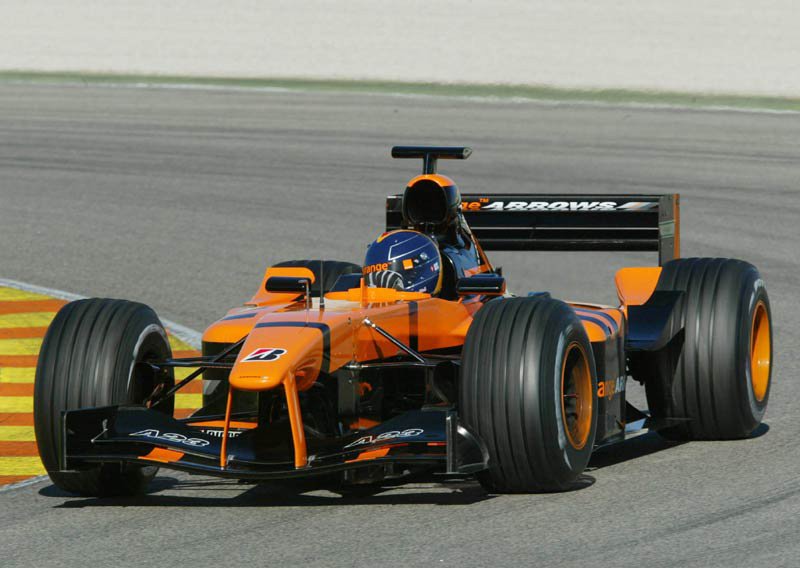
Arrows A23 test 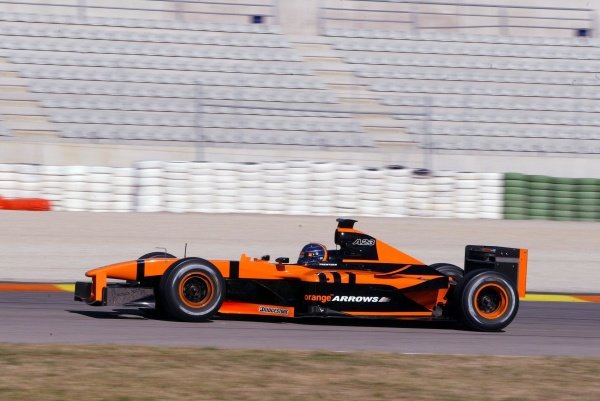
Arrows A23 test
Barcelona Testing 11 – 13 February 2002
Not long after the first test sessions at Valencia the Orange Arrows team travelled with the Arrows A23 and the rest of the team to the track at Barcelona. Heinz-Harald Frentzen and Enrique Bernoldi tested with the car. Moreover, Frentzen once more showed the potential of the car by setting the third time overall.
Test Report 11 Feb, Test Report 12 Feb, Test Report 13 Feb
Silverstone Testing 18 – 21 February 2002
Five days after the test in Barcelona Arrows travelled to Silverstone for another test session. While the weather conditions were far from, perfect Arrows kept on testing the car. Both Frentzen as Bernoldi showed the cars reliability compared to the predecessor the Arrows A22. The test on the last day was on the shirt circuit of Silverstone.
Test Report 18 Feb, Test Report 19 Feb, Test Report 20 Feb, Test Report 21 Feb
The team went with a good feeling to the first race of the season in Australia. Still testing times don’t mean anything in the Formula One. While the engine showed it’s lack of reliability the grid positions of both Frentzen and Bernoldi looked promising for the rest of the season. Both out qualified the Minardi’s and the Jaguar’s while Frentzen out qualified the Toyota from Allan McNish. With a P15 and P17 on the grid and close to Toyota, BAR and even Sauber in reach the team was confident.
However, the race turned out to be a big disappointment for the team, while the Arrows A23 did well the drivers were disqualified from the race. Frentzen received the black flag for ignoring the red Light at the end of the Pits. While Bernoldi got the black flag on lap 23 because the stewards deemed him to have switched to a spare car after the race began. For the young readers, back in 2002 every team had a spare car ready in their pitbox. In case of need, a driver could swap. I know they should re-introduce the T-car again.
While Orange Arrows showed decent progression during the qualification session. During the races, the reliability of the Arrows A23 was questionable. The chassis was great; it was the engine causing the problems for the team. The Cosworth engine was far from good. Jaguar was struggling as well. It took Bernoldi up to six races before he finished his first race at Monaco. Side note twice it was his own fault he did not finish the race. While Frentzen did it much better compared to Bernoldi. During the Spanish Grand Prix Frentzen scored the first point of the season by qualifying the car on the 10th place, and stay out of trouble during the race. At Monaco, he finished once more sixth. However, these would turn out to be the only two point Arrows would score.
The future for the Arrows team was far from bright it was dark! The team was in desperate need for money. The team failed to pay suppliers like Cosworth. Still the team kept on testing the Arrows A23. From the 10– 12 July, several teams were testing at Valencia. So did Arrows the full three days. The results of the testing were decent and good to write about to home. Interesting was to see that Sébastien Bourdais, at that time a F3000 start, was testing for Arrows as well. On Day two and day Three.
Test tesults day One, Test results day two, Test results day three
At the time the Formula One traveld towards Magny-Cours for the French Grand Prix It was clear that Arrows had a huge problem. While the team was active at Silverstone, it was far from at Magny-Cours. Both cars skipped the Free practice sessions only to appear on the track during the qualification session. Frentzen and Bernoldi however failed to qualify their Arrows A23 cars. What was going on? On purpose, it seems, they drove slow around the track. As soon a time was set both Frentzen and Bernoldi drove back in the pits, and could back home as they did not improve their times;
Time to set 1:17.023 (107%)
Heinz-Harald Frentzen 1:18.497 +6.512
Enrique Bernoldi 1:19.843 +7.858
Arrows skipped the risk of a fine of 500.000 dollar by not attending a race by try to qualify the cars, opinions on and around the track on the move Arrows made were far from positive. Tom Walkinshaw replied once more that he was in speaking term with Morgan Grenfell bank to seek for opportunities to save the team. It seemed the team was saved as they travelled to Hockenheim for the German Grand Prix. It started well with a good pace during the free practice. Sadly, the qualification and the race itself ended in a drama. Where both drivers had a great start, they would end up in a stall and a blown engine. Disappointed the team went back home to Leafield. It turned out to be the last time the Arrows trucks left a circuit.
Who will drive the last four races for Arrows?
After the Germany Grand Prix rapidly some weird story line occurred around the Arrows team. Heinz-Harald Frentzen was earlier rumoured to replace the injured Jarno Trulli at Jordan, though now the rumours appeared of a drive at Toyota for the last four races as Frentzen had left the Orange Arrows team. Would Verstappen take his place in the Arrows A23? The car that in the beginning was built around Verstappen. Even Huub Rothengatter, manager of Verstappen, looked into it even though Verstappen and Arrows were locked in a court battle. Sébastien Bourdais who tested previously with the Arrows A23 was named as one of the drivers as well. Even Tomáš Enge was rumoured.
However, Arrows would go to the Hungaring with both their Arrows A23 cars, though only with one driver Enrique Bernoldi. The second driver was still not secured and it could be that only Bernoldi would drive in Hungary. However, on the Tuesday for the race weekend the Arrows trucks were ordered to turn back to Leafield by the management team. It was said as well that the team employees were not paid at all. The team arrived however at Spa for the Belgium Grand Prix but would not be active during the weekend. While The FIA set, an ultimatum for Monza Arrows would not re-appear with the Arrows A23 on a circuit.
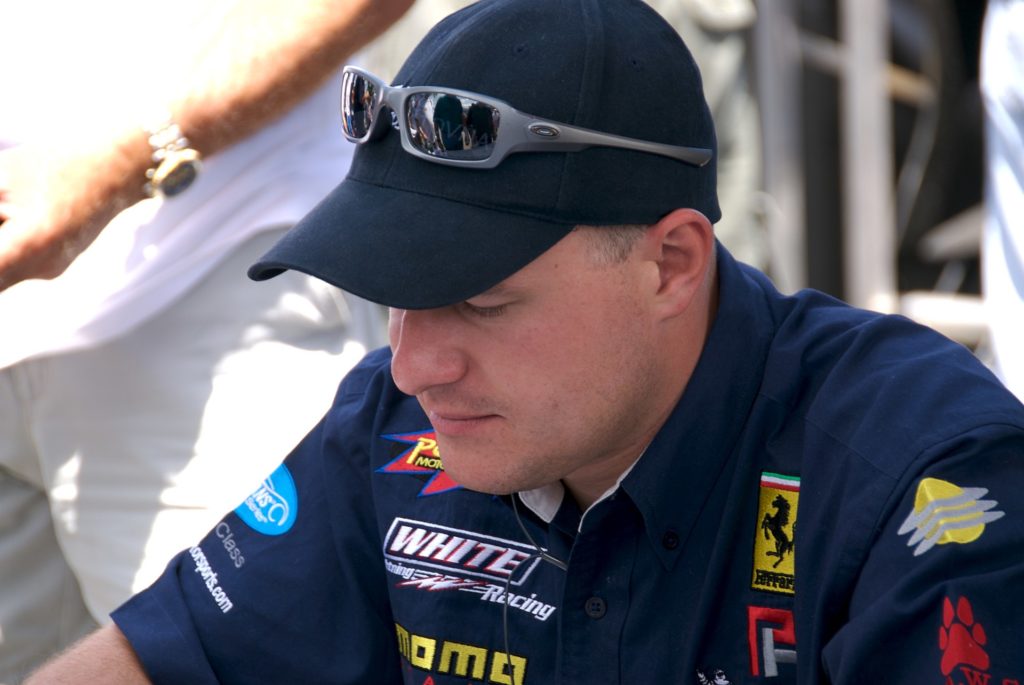
Tomáš Enge or 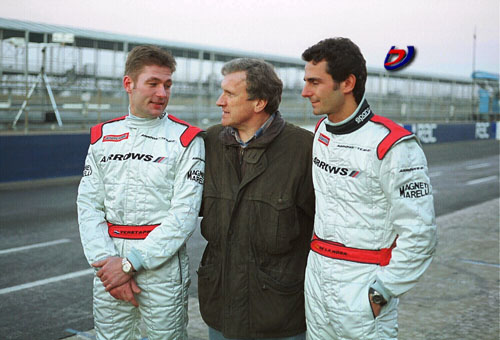
Will it be Jos Verstappen ?
The Aftermath, Arrows to be saved or not?
While the drama at Orange Arrows unfolded rapidly with a lot of finger pointing to each other, rumours started to appear of groups who were interested to take over the Arrows team. Therefore it seemed that the team was saved already in the summer. It started with Craig Pollock the former team boss of B.A.R. who did several attempts with a consortium of mostly American backers to save the team. They wanted up to 40% of the team’s shares. Pollock came even close to save the team, though Walkinshaw held off the offers it seems. In the end Pollock lost interest in saving the team.
After the Belgium Grand Prix, 30 August 2002, Tom Walkinshaw came with the news that an American investor had saved the team by purchasing it. It was said that billionaire Carl Smith, 80 years old, had purchased the team. He earned his money in the mining industry. Weeks after the announcement was made there was radio silence from the team. And it seems the American investor lost it’s interest in the team.
Then there was the interesting story of an All-American team led by Phil Hill and Dan Gurney. Their plan was to purchase the Arrows team backed by several American companies to create an all American Formula One team. Similar to USF1 was to become in 2010. The plan was to debut in 2004 with an evolution of the Arrows A23. Though the plans were American style big, It seemed soon after the story appear as quickly the story left the paddock.
Earlier in the season Red Bull owner Dietrich Mateschitz was interested as well to take over the Arrows team. It was no secret that Red Bull was looking at the Formula One. They were already a sponsor of Arrows, and an eventual take-over of the team by them was a serious option. Probably Walkinshaw asked a price that was too much for the team, which led Red Bull to look further.
Perhaps the most serious attempt to rescue the Arrows team was from Oliver Behring who did several times an attempt with the unknown Asset Trust Partners, a group or Arab investors, to take over the team. The plan was to rebrand the team to German Grand Prix Racing and have the team based in Germany. They failed to agree a deal and tried a second time to take over a team in 2003. The story can be read here.
The Arrows team In the meantime lost their main sponsor Orange, Lost Boys decided it was enough and turned the Website offline. While the debts they had with Cosworth were not paid at all. Still there was some opportunism when Arrows did an attempt for an entry in 2003 which was denied by the FIA and eventually was one of the last times arrives was heard off.
However, this meant not the end of the Arrows A23, part two will about Paul Stoddart from Minardi who purchased five Arrows A23 chassis in 2003 to compare them with their own Minardi PS03B.

